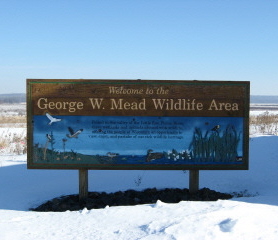Mead Wildlife Area facts for kids
Quick facts for kids Mead Wildlife Area |
|
|---|---|

Welcome sign at the Mead
|
|
| Type | State wildlife area |
| Location | Marathon, Portage, and Wood counties |
| Area | Over 33,000 acres (13,000 ha) |
| Created | 1959 |
| Hiking trails | 70 miles (110 km) |
The Mead (George W.) Wildlife Area is a huge natural space in central Wisconsin. It covers more than 33,000 acres (130 km2) of land. This area spreads across parts of Marathon, Portage, and Wood counties.
The Wisconsin Department of Natural Resources (WDNR) takes care of the Mead. People often just call it "the Mead." A team of five WDNR staff members work hard to manage this special place. Also, a group called Friends of the Mead/McMillan Association, Inc. helps raise money to support all the activities here.
The Mead has over 70 miles (112 km) of trails for hiking. There's even a 7-mile (11 km) loop around the Berkahn Flowage. This area is a fantastic home for birds. Every year, 291 different kinds of birds visit the Mead. As of 2018, 278 bird species have been seen here. Plus, 126 bird species are known to build their nests and raise their young in this area.
Contents
A Look Back: History of the Mead
In the early 1900s, people thought the low-lying lands here could be used for farming. They dug ditches and straightened the Little Eau Pleine River to drain the water. But farming didn't work out. The ground was too cold and acidic for crops to grow well.
In 1933, there were plans to build two large water storage areas (reservoirs). These would hold water from the Big and Little Eau Pleine Rivers. A company bought the land for this purpose. The dam on the Big Eau Pleine River was built in 1936. However, the dam for the Little Eau Pleine River was never built. Many people, including nature lovers and local residents, were against it. This dam would have created Wisconsin's second-largest lake.
On April 10, 1959, something amazing happened. Stanton W. Mead, who was the president of a paper company, gave 20,000 acres (81 km2) of land to the State of Wisconsin. He wanted it to be used as a state wildlife area. The area is named after his father, George W. Mead. The Visitor Center is named after Stanton himself. The governor at the time, Gaylord Nelson, came to the special ceremony. Since then, more land has been bought or given to the Mead.
The same WDNR team that manages the Mead also takes care of the McMillan Marsh Wildlife Area. This area is about 7,500 acres (30 km2) in size. It's located just one mile (1.6 km) north of Marshfield. It gets its name from the town where it is located. When people talk about both areas together, they often say "Mead/McMillan."
Why the Mead Wildlife Area is Important
The Mead Wildlife Area has many different kinds of natural places. These include grassy fields, wet areas called bogs, thick forests, wetlands, ponds, and even some farm fields. In general, the area is made up of about 13,000 acres (53 km2) of forest, 14,000 acres (57 km2) of wetlands, and 6,000 acres (24 km2) of grasslands.
The Mead Wildlife Area has three main goals:
- Managing its natural resources.
- Managing outdoor activities for visitors.
- Providing environmental education.
Caring for Nature: Resource Management
This goal means taking care of all the different natural areas. For example, grasslands are kept healthy by using controlled burns. This is when experts carefully set small fires to help new plants grow. Forests are managed using methods that help them stay healthy for a long time.
The ponds and water areas are surrounded by special walls called dikes. Pumping stations and water control structures help manage the flow of water. This ensures the right amount of water is in each area. Many universities and government wildlife groups also do research here. They study the plants and animals to learn more about them.
Fun Outdoors: Recreation Management
The Mead is a great place for many outdoor activities. People can go hunting, fishing, trapping, hiking, birding, and biking. Most parts of the Mead are open to the public all year. However, some special areas are set aside as wildlife refuges. These areas are protected for the animals.
Most of the dikes and old logging trails are open for walking. One dike even has a special bike trail. There's also a specific area where people can train their hunting dogs. Signs mark all the outside edges of the Mead.
Learning About Nature: Environmental Education
The Mead offers special learning programs for students. Schools from nearby areas often bring their students here. These programs are designed for elementary school children. They also help teachers learn more about environmental education.
Explore the Visitor Center
The Stanton W. Mead Education and Visitor Center is a modern building. It was built in 2005 and is 6,208-square-foot (576.7 m2) in size. This center was designed to be very eco-friendly. It uses many green technologies. For example, it was built with materials that are good for the environment. It also uses solar power for heating water and electricity. It even uses wind power and geothermal energy for heating and cooling! The building's design won an award in 2006 for its focus on sustainability and energy efficiency.
Most of the money for the Center came from private donations. Many materials and services were also given for free. The State of Wisconsin also helped by contributing money to the project.
The Visitor Center is where the WDNR staff work. It also stores equipment used to manage the area. Most importantly, it's a key place for all the environmental education programs.

